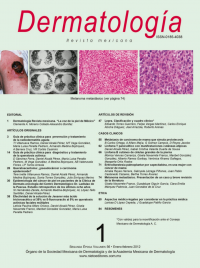RESUMEN
Antecedentes: la radioterapia es uno de los pilares en el tratamiento de pacientes con cáncer. Cualquier paciente que reciba un esquema de radioterapia experimentará algún grado de radiodermatitis; la mayoría padece grados 1 y 2. Objetivo: enumerar, con base en la mejor evidencia científica, los parámetros para prevenir y tratar la radiodermatitis aguda que padecen los adultos que reciben radioterapia. Material y método: para la búsqueda de Guías de práctica clínica se utilizaron preguntas clínicas y estructuradas. Se encontraron cuatro guías, de las que sólo una se apegaba al tema. Se amplió la búsqueda para incluir revisiones sistemáticas, metanálisis, estudios clínicos controlados, de cohorte y otros descriptivos. Resultados: aunque se han realizado varios estudios, se menciona que son muy pocas las intervenciones que tienen buen nivel de evidencia y grado de recomendación, como: medidas de higiene, esteroides tópicos, enzimas orales hidrolíticas y amifostina, para evitar grados mayores de radiodermatitis. Para el tratamiento de la radiodermatitis aguda se han realizado menos estudios, con muy pobres resultados. Conclusiones: esta Guía ofrece la mejor evidencia actual para prevenir y tratar radiodermatitis aguda en pacientes adultos –de uno y otro sexo– que reciben radioterapia, auxilia a los dermatólogos para que tomen decisiones terapéuticas adecuadas y estimula la investigación científica. Palabras clave: radiodermitis aguda, toxicidad cutánea por radioterapia, complicaciones de la radioterapia.
Palabras clave: radiodermitis aguda, toxicidad cutánea por radioterapia, complicaciones de la radioterapia
ABSTRACT
Background: Radiotherapy is a mainstay in the treatment of oncology patients. Any patient undergoing a radiotherapy scheme will experience some degree of radiodermatitis, most of them degrees 1 and 2. Objective: To list, based on the best scientific evidence currently available, the parameters to prevent and treat acute radiodermatitis that adult patients undergoing radiotherapy, have. Material and methods: Structured and concrete clinical questions were formulated with a standardized sequence to search for practice guidelines. Four guidelines were found from which only one was really attached to the same subject. Results: Although there have been several trials, only few interventions have good level of evidence and degree of recommendation to prevent higher degrees of radiodermatitis (hygiene, topical steroids, oral hydrolytic enzymes and amifostine). For acute radiodermatitis treatment, only few studies have been made and, even those, show very poor results. Conclusions: The following Practice Guideline provides the best current scientific evidence for prevention and treatment of acute radiodermatitis in adult patients of either sex undergoing radiotherapy, and helps dermatologists in making good therapeutic decisions, and encourages scientific research. Key words: acute radiodermatitis, acute radiodermitis, cutaneous toxicity due to radiation, radiotherapy complications.
Keywords: acute radiodermatitis, acute radiodermitis, cutaneous toxicity due to radiation, radiotherapy complications

